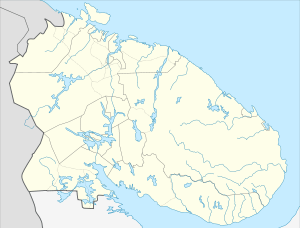Poyakonda
| Poyakonda Пояконда (Russian) | |
|---|---|
|
- Rural locality[1] - Inhabited locality[1] | |
_-_panoramio.jpg) Landscape of Poyakonda | |
.svg.png) Location of Murmansk Oblast in Russia | |
 Poyakonda | |
| Administrative status (as of 2010) | |
| Country | Russia |
| Federal subject | Murmansk Oblast[1] |
| Administrative district | Kandalakshsky District[1] |
| Statistics | |
| Population (2010 Census) | 78 inhabitants[2] |
| Time zone | MSK (UTC+03:00)[3] |
| Postal code(s)[4] | 184040 |
| Dialing code(s) | +7 81533[5] |
Poyakonda (Russian: Пояконда) is the rural locality (an inhabited locality) in Kandalakshsky District of Murmansk Oblast, Russia, located beyond the Arctic Circle at a height of 6 meters (20 ft) above sea level.
On November 17, 1987, the Presidium of the Supreme Soviet of the Russian SFSR decreed to transfer the settlement of the railway station of Poyakonda from Tedinsky Selsoviet of Loukhsky District of the Karelian ASSR to Murmansk Oblast.[6] By the Decision of the Murmansk Oblast Executive Committee of January 20, 1988, the settlement was merged with the inhabited locality of Poyakonda on the territory in jurisdiction of the town of Kandalaksha.[6] The transfer marked the only time the external borders of Murmansk Oblast changed between 1947 and present.
As February 2018, the hamlet had 50 residents, most working at the White Sea Biological Station bioscience research facility run by the Moscow State University on the White Sea coast. In December 2017, Russian Railways removed the railway station from their Murmansk-St. Petersburg service. Services were resumed when it was realised a 14 year old girl relied on the service to travel to school, which came to international attention.[7][8][9][10]
References
Notes
- 1 2 3 4 OKATO, Part 2. Code 47 408 558
- ↑ Статистический сборник Численность, размещение и возрастно-половой состав населения Мурманской области. Итоги Всероссийской переписи населения. Том 1. 2012 Archived December 22, 2012, at the Wayback Machine. / Федеральная служба государственной статистики, Территориальный орган Федеральной службы государственной статистики по Мурманской области. Мурманск, 2012 — 75 с.
- ↑ Правительство Российской Федерации. Федеральный закон №107-ФЗ от 3 июня 2011 г. «Об исчислении времени», в ред. Федерального закона №271-ФЗ от 03 июля 2016 г. «О внесении изменений в Федеральный закон "Об исчислении времени"». Вступил в силу по истечении шестидесяти дней после дня официального опубликования (6 августа 2011 г.). Опубликован: "Российская газета", №120, 6 июня 2011 г. (Government of the Russian Federation. Federal Law #107-FZ of June 31, 2011 On Calculating Time, as amended by the Federal Law #271-FZ of July 03, 2016 On Amending Federal Law "On Calculating Time". Effective as of after sixty days following the day of the official publication.).
- ↑ Russian Post. Эталонный справочник индексов объектов почтовой связи (in Russian)
- ↑ Народная энциклопедия городов и регионов России «Мой Город» (in Russian)
- 1 2 Administrative-Territorial Division of Murmansk Oblast, p. 58
- ↑ Shevchenko, Vitaly; Allen, Kerry (9 February 2018). "Train introduces stop for single schoolgirl". BBC News. Retrieved 13 February 2018.
- ↑ "Special Delivery: Trains Now Stop in Russian Northern Wilderness for One Girl". Sputnik News. 9 February 2018. Retrieved 13 February 2018.
- ↑ "Train goes the extra mile for lone Russian schoolgirl at remote station". TASS. 9 February 2018. Retrieved 13 February 2018.
- ↑ "14-Jährige bekommt ihren eigenen Zug-Stopp". 20 Minuten (in German). 12 February 2018. Retrieved 13 February 2018.
Sources
- Архивный отдел Администрации Мурманской области. Государственный Архив Мурманской области. (1995). Административно-территориальное деление Мурманской области (1920–1993 гг.). Справочник. Мурманск: Мурманское издательско-полиграфическое предприятие "Север".
External links
- Kandalaksha.su. Poyakonda